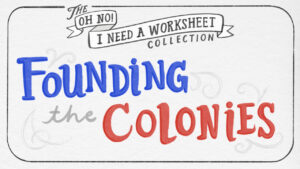Grade 6
-
Language
-
Reading: Informational
-
Reading: Literature
-
Speaking & Listening
-
Writing
CCSS ELA Standard: 6.L.4
Determine or clarify the meaning of unknown and multiple-meaning words and phrases based on grade 6 reading and content, choosing flexibly from a range of strategies.

Founding The Colonies
13 colonies activities including a word search and task cards packed with facts. Plus, students will create their own colony with a name, story, and map!

Antagonyms: Dust, Clip, and Left
Dust can mean “remove dust” but also “add more dust!”

Plexidemokinesis (Greek and Latin)
Using the word Plexidemokinesis, students will create an invention, a creature, or a spell.

Psycholunaphase (Greek and Latin)
Using the word Psycholunaphase, students will create an invention, a creature, or a spell.

Hydromagnaphone (Greek and Latin)
Using the word Hydromagnaphone, students will create an invention, a creature, or a spell.

Geosynth (Greek and Latin)
Using the word Geosynth, students will create an invention, a creature, or a spell.

Thermocryptograph (Greek and Latin)
Using the word Thermocryptograph, students will create an invention, a creature, or a spell.

Aquamorphotron (Greek and Latin)
Using the word Aquamorphotron, students will create an invention, a creature, or a spell.

Chronosonarium (Greek and Latin)
Using the word Chronosonarium, students will create an invention, a creature, or a spell.

Pyrostasis (Greek and Latin)
Using the word Pyrostasis, students will create an invention, a creature, or a spell.

Greekymon Studies – Round 3
What might a creature named “Aquacornus Rex” be like?

Greekymon Studies – Round 2
What might a creature named “Hypermnemonicus” be like?

Greekymon Studies – Round 1
What might a creature named “Ursolunascope” be like?

Multiple Meaning Matcher – Theta
Can your students match multiple meanings of the same five words?

Multiple Meaning Matcher – Eta
Can your students match multiple meanings of the same five words?

Multiple Meaning Matcher – Zeta
Can your students match multiple meanings of the same five words?

Multiple Meaning Matcher – Epsilon
Can your students match multiple meanings of the same five words?

Multiple Meaning Matcher – Delta
Can your students match multiple meanings of the same five words?

Multiple Meaning Matcher – Gamma
Can your students match multiple meanings of the same five words?

Multiple Meaning Matcher – Beta
Can your students match multiple meanings of the same five words?

Multiple Meaning Matcher – Alpha
Can your students match multiple meanings of the same five words?

Idioms About Money
Five sets of idioms related to money.

Idioms About Fire
Five sets of idioms related to fire!

Idiom Tasks
Four fantastically terrific tasks for a weekly idiom study.

Idioms about Weather
Five sets of idioms related to the weather.

Idioms About Red
Five sets of idioms related to the color red.

Sets of Idioms Related to Numbers
Two sets of idioms related to numbers.

Five Sets of Bird and Bug Idioms
Five sets of idioms related to birds (and bugs).

Sets of Idioms Related to Body Parts
Five sets of five idioms, all related to body parts!

Sets of Idioms Related to Food
Five sets of five idioms, all related to food.

Greek and Latin Word Part Paths
How can we go from Biology to Immobile?

Sets of Idioms
An ongoing series to expose students to five related idioms.

Multiple Meaning Matcher – Introduction
Your students will try to match up definitions that belong to the same homophone in this brain-boggling vocab puzzle.

Ongoing Greek and Latin Word Part Activities
Rather than just memorizing word parts, students will use those word parts to create four possible products.